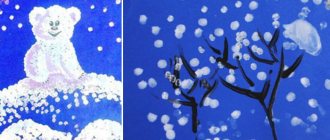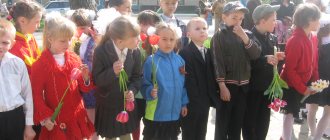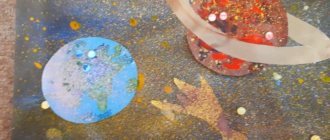Brushes aside, friends... (alternative drawing techniques)
Contained in sections:
- Drawing. All materials 31147
Includes sections:
- Batik and fabric painting 201
- Scratch. Drawings, master classes, classes 350
- Drop therapy, caplegraphy. Games and drawing with a pipette 39
- Blotography. Drawing blots 439
- Semolina. Drawing with semolina and semolina 263
- Milk. Drawing on milk 27
- Monotype. Master classes, drawings, classes 324
- Bubble. Drawing 249
- Splashing, drawing technique 95
- Unconventional drawing techniques. Plans 101
- Unconventional drawing techniques. Projects 201
- Unconventional drawing techniques. Self-education 135
- Nitcography. Drawing, applique, thread paintings 672
- Finger painting. Drawing with fingers and palms 1802
- Plasticineography, plasticine 3854
- Foam sponge. Drawing 129
- Pointillism. Drawing with cotton swabs 701
- Drawing with a rope 22
- Drawing with a fork 107
- Drawing with liquid salt dough 45
- Drawing with shaving foam 104
- Drawing with plastic bags and films 64
- Drawing with Marbles 6
- Light table. Drawing on sand light tables 84
- Salt. Painting with salt 339
- Wool watercolor. Drawing with wool 123
- Stamping. We print and draw with stamps 866
- Ebru. Drawing technique 240
- Encaustic. Drawing with an iron 46
By groups:
- Senior group
- Preparatory group
- Middle group
- Junior group
Showing publications 1-10 of 11391. All sections | Unconventional drawing techniques
New
Photo
The best
Workshop for teachers “Non-traditional drawing techniques as a way to develop creativity in preschool children” Workshop for teachers. “ Non-traditional drawing techniques as a way to develop the creative abilities of preschool children. Winter." Goal: To introduce teachers to some non-traditional drawing techniques , to continue to improve the skills of teachers in...
Lesson on drawing using an unconventional method - using cardboard sleeves "Festive fireworks" in the second junior group
Goal: To teach children to draw using an unconventional drawing technique cardboard sleeves (the “stamping”
) festive fireworks.
Objectives: Educational: Introduce a new technique of drawing with sleeves , fix colors (red, yellow)
Developmental: Develop in children...
Summary of a lesson using non-traditional teaching methods for speech development “Igrachka”
Summary of educational activities using non-traditional teaching methods for speech development in the senior group with children with general speech underdevelopment
.
“Player”
Goal: Expansion and activation of verbal communication.
Tasks:
• improve the grammatical structure of speech
,
• learn to select action words, select nouns for adjectives,
• develop logical thinking
,
• develop proper breathing
,
• develop
visual and auditory attention,
• to develop the skills of cooperation, mutual understanding, goodwill, and independence.
Equipment: aroma lamp, candle, subject pictures, subject pictures, wooden puzzles.
Progress of the lesson.
I. Organizational moment.
1. Using aromatherapy
.
Children inhale the smells of spring flowers and herbs. (oil burner)
.
2. Breathing exercises.
- inhale through the nose and exhale through the mouth;
- inhale through the mouth – exhale through the nose;
- inhale through the nose, exhale through one nostril, the other nostril;
3. Using a candle
, game
"Candle"
.
Children sit on the carpet in a circle around a candle.
- Guys, you know that in the spring everything comes to life, our candle also comes to life (the speech therapist lights the candle)
.
Children feign surprise. Children look at the flame and are asked to pretend to be happy. Children are then asked to close their eyes (music plays)
.
Children open their eyes and answer the speech therapist’s questions:
-What did you imagine when you looked at the candle flame? (children's answers)
.
The speech therapist suddenly blows out the candle flame and asks you to pretend to be upset.
II. Main part.
- So that you don’t get upset, we will only play today.
1. Let's go play the first game.
-Who or what can go? (children's answers: it is raining, it is snowing, spring is coming, a boy is coming, a dog is coming, time is coming, smoke is coming.)
Children go to a magnetic board where there are pictures with antonym words. Children say each picture (for example: “In this picture the horse is white, and in this one it is black.”)
2. Play the next game.
a) - Who or what can play (children’s answers: a girl is playing, a musician is playing, a cat is playing, a pipe is playing, the sun is playing).
The speech therapist invites the children to sit on a chair.
b) Game “Sun”
.
(self-massage)
-A sunbeam looked into your eyes. It ran further down the face.
Gently stroke it with your palms on the forehead, on the nose, on the mouth, on the cheeks, on the chin. Stroke it carefully so as not to scare it away. Stroke your head, neck, belly, arms, legs. He climbed up behind the collar, pet him there too. He is not a mischievous person, he loves and caresses you. And you pet him and make friends with him. Smile at him.
c) -You said that a musician is playing. What kind of sounds do you think exist besides those made by musical instruments? Let's listen and try to determine what sound we got. (behind the screen the teacher makes sounds: knocking on wood, iron, glass.)
-Guys, you heard the sound, now guess how it turned out. (children's answers: this sound will be made if you knock on wood, iron, glass).
3.-While you are playing, time flies quickly. Who or what else might be running?
(children's answers : a dog is running, a stream is running, a man is running)
Game "Reincarnation"
.
Children run, pretending to be a man or a bear.
Having walked the path, the child pronounces his actions (children’s answers: “I ran like a man”
,
"I ran like a bear"
.)
4. Game "Puzzles"
.
a) The bear was so clumsy that he touched the puzzles and they fell apart. Let's put the puzzles together and see what is depicted on these puzzles.
Children assemble puzzles, the speech therapist asks leading questions, encouraging children to pronounce their actions.
-Who are you collecting, why did you decide that? (children's answers)
.
b) An image of animals appears on the completed puzzles. The speech therapist invites each child to tell about the animal, naming what kind it is?
III. Final part.
Guys, our game has come to an end, our time has passed and we now know that it can also run just like us. We collected the animals and talked about them. And you can tell about yourself, what you were like now.
(children's answers)
Notes on non-traditional drawing techniques in the senior group “Painting with salt”
Summary of an open lesson on visual arts using non-traditional drawing methods (painting with salt (sprinkling technique))
in the senior group on the topic: “Birch in winter attire”
Goal: to create conditions for the activation of speech and creative abilities during visual activities.
Tasks:
1. Educational: continue to teach children to draw a tree: trunk, branches. To shape children’s need for self-expression through visual activities. Introduce a new technique of unconventional drawing - the pouring technique. Strengthen the ability to mix paints.
2. Developmental: develop children's speech and creative abilities in the process of drawing. Develop fine motor skills, perseverance, attention, imagination and sense of composition. Develop the ability to comment on your actions.
3. Educational: to cultivate in children a sense of beauty, love for their native land through fine art and poetry. To cultivate an aesthetic attitude towards nature and its depiction in drawing. To develop independence in drawing and accuracy when working with paints.
Preliminary work: observing winter trees on a walk, looking at reproduction paintings and talking about them, reading and memorizing poems, listening to music, free drawing.
Materials and equipment: gouache paints, tinted paper, brushes for glue and painting, PVA glue, salt, napkins, audio recording of P. Tchaikovsky “The Seasons”.
Progress of the lesson
Educator:
I'll tell you a riddle,
And you solve it...
Many hands, but one leg... (Tree)
- That's right, it's a tree. What parts does a tree have? (Trunk, branches, leaves). A tree looks like a person. The trunk is the body, the roots are the legs, the branches are the arms, the shoots extend from the branches - the fingers, the bark is the skin of the trees. The older the tree, the more wrinkles there are. The snow lying on the branches is the clothing that people wear when cold weather sets in.
The teacher shows a reproduction of Grabar’s painting “February Blue” and a photo of “Snow-Capped Birches.”
Educator: The birch is called a symbol of Russia. The original name was given to her on behalf of Beregini, an ancient Slavic goddess who was the mother of all good intentions and spirits. Birch is an excellent air purifier. In spring, a birch tree can produce a bucket of sap in a day. Birch brooms can heal, cleanse, filling the human body with vitamin C and essential oils. In the old days, a birch torch was considered the best for lighting peasant huts - it burns brightly and without soot. But the main value of birch for us, Russians, is in its beauty, grandeur, and soulfulness. It is not without reason that poets, composers and artists at all times dedicated their works to her.
Lesson summary “Unconventional drawing methods”
— Did everyone succeed? (Check for correct execution in children).
- Well done.
- What else is our bird missing? (- Tail, eyes and beak)
- Certainly. Let's do the ponytail. And here a brush will help us.
- First, I draw the tail, and you watch.
“I dip the brush again in black paint and draw a small line down the middle, a little below the branch, and then add two feathers at the tail on each side.
— Is the task clear? (- Yes)
— Draw the bird’s tail yourself.
— Put black paint on the brush and draw a middle line and two on the sides. Vika does it with me. (See the guys' work)
- Well done. Wash the brush and place it on a napkin, let it rest for a while.
- Well, our bullfinch is almost ready.
- Now we need to make eyes for our birds. Look how I do it.
— I’ll take a cotton swab, dip it in white paint and put two white dots. Now I need to add the pupils. I'll turn the cotton swab over and put some black paint on the clean side. I'll put small dots in the middle of the eyes, these will be the pupils.
- Now you add eyes to your birds. (Check the result, help Vika)
— Have we drawn everything to the bullfinches? (- No)
- What is missing? (- Beak)
- Well done. You are very attentive.
— We will paint the beak with yellow paint, using a thin brush. I'll do it first. Look how.
-I take a small brush, pick up yellow paint and paint a small beak. (Show)
- Now you draw a beak for your birds. (Help Vika)
- Look how beautiful your bullfinches turned out.
— Bullfinches come to us with the first snow. Let's draw snowflakes too. To do this, take a clean cotton swab, dip it in a jar of blue gouache and apply small dots on our drawing, as if it were snowing. When making snowflakes, we again meet with the impression, only this time we make the impression with a cotton swab.
— We remove the cotton swabs.
VII. Lesson summary
- Look at your work. What beautiful birds you have made. Did you like them? (-Yes)
— At the beginning of the lesson, we talked about the fact that bullfinches really like to feast on rowan berries. Let's treat our bullfinches with rowan berries.
— Take a clean cotton swab, dip it in red paint and draw berries on a branch:
draw some berries - if you liked our lesson today and you are very pleased with your work
1 berry - if the lesson was boring and you think that you could do your job better.
I really liked today’s lesson, because you all tried hard, completing a new and difficult task. Therefore, I will also draw berries for my bird, and I will draw four of them, because I had four diligent students in my lesson today.






